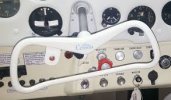Spunk
New Member
- Joined
- Jul 9, 2019
- Messages
- 26
I'm just about to have my autopilot installed in my 1965 Cessna 182H and was wondering what people have for yoke-mounted disconnect switches. What switch are you using (where did you get it, what type) and how is it mounted on your yoke? Pictures would be great too! I'd like to 3D print some kind of bracket to house the comm and disconnect switches so I'm fishing for ideas. Pic is of my current yoke with a janky PTT switch!


